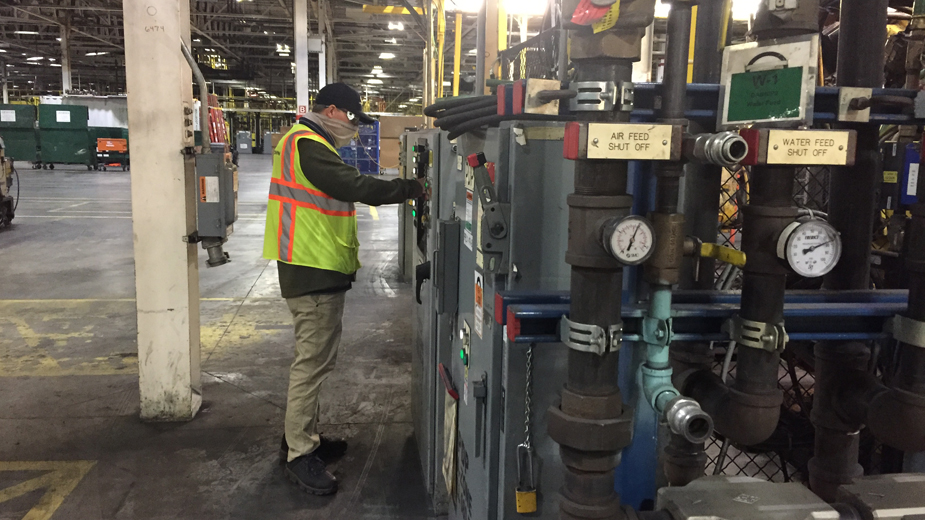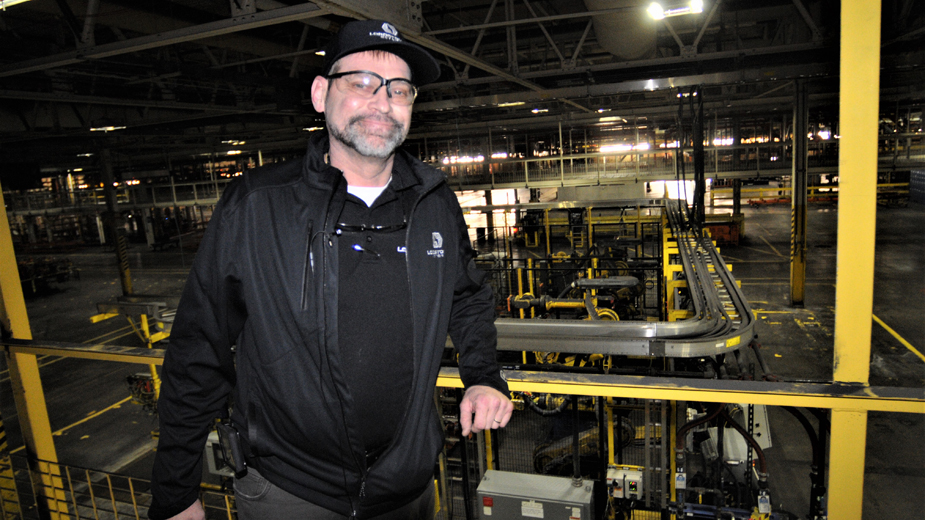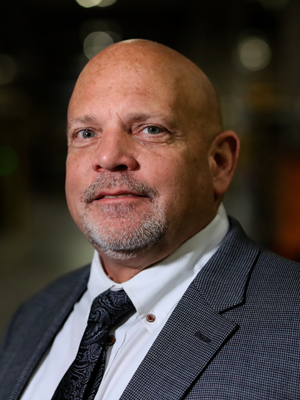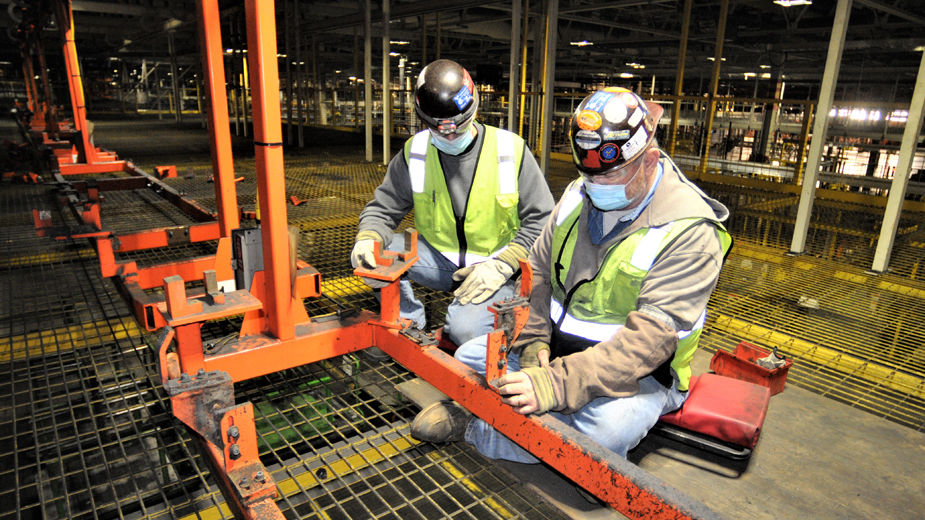LORDSTOWN, Ohio – Marty Clark and Bob Stevens, millwrights for Kansas City-based Genesys Systems Integrator, remove old tooling from a carriage that once moved bodies of the Chevrolet Cruze for General Motors at its Lordstown complex. Now, these carriages are being retrofitted for an entirely new product and company, the all-electric Endurance pickup produced by Lordstown Motors Corp.
In another part of the plant, David Bradford, a controls, engineering and body specialist, revs up a robotic welder for a quick test. Meanwhile, other contract workers move about the sprawling manufacturing complex as they accelerate efforts to retool the former GM plant – a facility that many thought was shuttered for good.

“We’re now reviewing equipment processes and coming to an agreement on how we put the shop back together,” says Ronald Trautzsch, director of stamping and body assembly at Lordstown Motors. “This shop was designed to build 400,000 units a year for a sedan. What we’re doing is modifying it to be able to build a cab.”
That means pulling out much of the equipment from its base – a process called “due care” removal, Trautzsch says. This includes removing 987 robots and then reinstalling them in a new configuration, he says.
Trautzsch says this part of the plant – the former GM West complex – will be used for body and underbody assembly.
The East complex, or the assembly operation, would be used to build electric vehicle chassis – replete with new battery and hub motor architecture – and then marry the body with the undercarriage to manufacture the new vehicle.
Once the equipment is running at full speed, the cycle time would allow production of a new vehicle every 120 seconds, Trautzsch says.

“GM did a good job of shutting it down, so we know everything works.”
Lordstown Motors is building its alpha test models at a newly opened engineering center in Farmington Hills, Mich.
“The alpha is really an engineering vehicle,” says Rich Schmidt, president of Lordstown Motors. “All of our design and engineering is done here.”
Schmidt says that there’s just one alpha test model left to build before it ramps up production of its beta program at the Lordstown plant in January.
“We’ll be building around 56 betas at the plant,” he says.
Each beta model is manufactured for a specific purpose, such as test crashes, braking, acceleration, temperature controls, or battery performance.

Once these models are tested and verified, the company will begin pre-production of the Endurance during the second quarter of 2021, and commercial production in the fourth quarter, he says.
The former GM plant’s equipment was well maintained during the shutdown, Schmidt says, which gives Lordstown Motors an advantage over other EV startups that are vying to be the first in the commercial marketplace with an electric pickup.
Currently, the company is retrofitting part of the assembly plant into a battery production and wheel-hub motor manufacturing operation, Schmidt adds.
Moreover, Lordstown Motors is actively hiring. The company employs about 250, mostly engineers and managers. About 60% of these employees are former GM Lordstown managers, he says.
“I’m averaging about 100 new employees per month. By the end of the year, I want to be close to 500,” at the company’s three locations in Lordstown, Farmington Hills, and a new software division in Irvine, Calif.
Some of those employees staffed at the Irvine division are the source of a recent lawsuit filed in U.S. District Court Central District of California by Karma Automotive against Lordstown Motors.
Karma, also based in Irvine, alleges that Lords-town Motors stole Karma’s trade secrets when the parties were engaged in a joint project to develop an infotainment system for the Endurance. The lawsuit includes exhibits that show Lordstown Motors abruptly cancelled the relationship and lured key Karma employees away to start a new division in California. The complaint alleges that these employees took with them proprietary information.
Lordstown Motors has dismissed the lawsuit as a “fantasy,” according to a company statement and papers filed with the court.
The California location will also serve as a sales and service division as well, Schmidt says, since the state is one of the top EV purchasers in the world. “California buys more electric cars than most countries,” he says.
Schmidt should know. The company president has a long history in the automotive industry, beginning his career with Toyota, then to Nissan, Hyundai and Volkswagen. Most of his duties involved starting and designing new plants.
“Then I got a call from a startup out west. I had never heard of them, actually,” he remembers. “It sounded interesting though.”
The startup was Tesla, and Schmidt interviewed directly with Elon Musk, the luxury electric vehicle manufacturer’s founder.
“I was hired by Elon Musk and during my four years there I reported to Elon Musk,” he says. While at Tesla, Schmidt helped launch the Model S and Model X, he says.
He also was instrumental in reviving a closed plant in Fremont, Calif., that was once part of a joint venture between GM and Toyota.
“I had about 650 people under me there,” he says.
After four years at Tesla’s California plant, Schmidt moved back to Kentucky where he started a consulting business. Then, about four years later, he accepted a position with Lordstown Motors as its chief production officer. He was named president of the company in October.
Schmidt says there are some basic similarities between starting the Tesla plant and reviving Lordstown, but also significant differences.
“You have shutdown union plants that were both owned by General Motors,” he says.
However, GM and Toyota repurposed much of the newer equipment at the California plant to other locations, leaving Tesla very little to work with.
“At Lordstown, we were left with a fully operational plant,” he says. “It needs a little refreshing and retooling, but the processes are proven.”
The acquisition of a fully equipped plant probably slashed a year of preparation and retooling work that Tesla had to endure, he estimates.
Schmidt says the Tesla team was pulled from locations all over the world, which often led to major differences within the management structure.
Not so at Lordstown, where the majority of the management team are former supervisors who worked at the plant under GM.
“We have a lot of experience on the team, the history of the team and the community, and have it fitted with very well seasoned veterans that have done multiple startups,” he says.
“We have a much better team than Tesla had going into the launch, we have a much better equipped facility than Tesla had.”
Plus, there were logistical challenges with Tesla, since most of its suppliers were located more than 2,500 miles away from the production site, Schmidt says.
Lordstown benefits from suppliers that are based within a few hours drive in Ohio and Michigan, he says.
“We can keep our inventory and costs down,” he says. “Those are advantages we have.”
Schmidt says he’s impressed with Lordstown Motors CEO Steve Burns’ vision and dedication to the company.
“I think he’s very family oriented to the team and the community,” he says.
The business plan is to target commercial fleets first at a competitive price, Burns has said.
Cost of the vehicle stands at $52,500. Lordstown Motors was able to keep the price low because there are just four moving parts in the Endurance – four hub motors on each wheel, he said.
To date, the company has 50,000 preorders for the vehicle, which it hopes to start producing in September. Burns has said that he expects the company to employ about 1,500 workers once the vehicle launches.
In August, Lordstown Motors announced it had merged with DiamondPeak Holdings Corp., a special purpose acquisition company, or SPAC. The merger infused $675 million into the operation – including a $75 million commitment from GM that factored in $50 million of “in kind” investments such as the sale of the Lordstown plant. In late October, Lordstown Motors listed publicly on the Nasdaq under the ticker symbol “RIDE.”
Today, Lordstown Motors is a potential competitor with Tesla, as that company also vies for a space in the all-electric pickup market.
As for Elon Musk, Schmidt says he hasn’t had contact with him recently.
“I’d get an email occasionally, but nothing since New Year of last year,” he says with a laugh. “We’ve been pretty busy.”
Pictured: Marty Clark and Bob Stevens retool components of a carrier that will convey the truck body.
